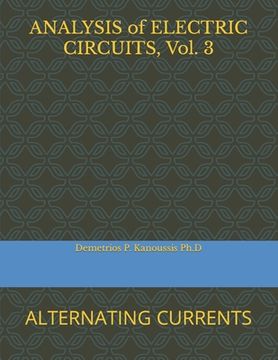ANALYSIS of ELECTRIC CIRCUITS, Vol. 3: Alternating Currents (en Inglés)
Reseña del libro "ANALYSIS of ELECTRIC CIRCUITS, Vol. 3: Alternating Currents (en Inglés)"
Circuit theory is a core course in every Electrical Engineering curriculum, with a wide range of applications to a variety of problems related to electrical systems and subsystems, such as power transmission systems, communication systems, control systems and electronics systems in general.This e book is the third volume of my e book series on Electric Circuits.In Volume 1, Introduction to Electric Circuits Theory, we present all fundamental concepts, definitions, principles and techniques on Electric Circuits, while In Volume 2, Direct Currents Circuit Analysis, we present a systematic analysis of DC circuits, i.e. circuits driven by DC sources.In the current volume we study Alternating Currents, i.e. the analysis of Electric Circuits driven by sinusoidal voltage and/or current sources. The content of this book is divided in 17 chapters.In Chapter 1 we introduce the periodic signals (wave forms), and define their average and RMS (effective) values, give a systematic and comprehensive introduction of the Algebra of Complex Numbers, (which greatly simplifies the analysis of AC circuits), introduce the extremely important Phasor Concept and show how to express sinusoidal functions of time by their Phasors representations.In Chapter 2 we develop the two fundamental Kirchhoff's Laws, the K.C.L. and the K.V.L. as applied to AC circuits (in terms of the Phasor representation of the currents and/or voltages involved) and derive the Ohm's Law in Phasor notation for the three basic circuit elements (Resistor, Inductor and Capacitor).In Chapter 3 we introduce the impedance and the admittance concept and show how to determine the total (equivalent) impedance or admittance of various impedances connected in series and/or in parallel.In Chapter 4 we present the Voltage and the Current division formula, in Phasor notation.In Chapter 5 we show how to transform a voltage source with internal impedance in series, to an equivalent current source in parallel with its internal impedance.In Chapter 6 we give a general introduction to the Power in AC circuits, define the Real, Reactive and Apparent Power, introduce the extremely useful concept of the Complex Power, define the Power Factor (leading or lagging) and explain why the Power Factor Correction is important in AC circuits, discuss the Energy Balance in AC circuits and state the Maximum Power Transfer Theorem. In Chapter 7 we present a systematic approach as how to convert a given AC circuit from the Time Domain (described by Differential Equations) to the Frequency Domain (described by linear equations with complex coefficients).In Chapter 8 we develop the Mesh or Loop Analysis method, based on the concept of the Loop Currents and which is ideal for circuits containing voltage sources only (independent and controlled). In particular, if the circuit contains independent voltage sources only, one may just by inspection write down the circuit equations for the Loop Currents.In Chapter 9 we develop the Nodal Analysis method which is based on the concept of the Nodal Voltage and is ideal for circuits containing current sources only (independent and controlled). In particular, if the circuit contains independent current sources only, one may just by inspection write down the circuit equations for the nodal voltages.In Chapter 10 the Source Transformation method is presented (Voltage Source to Current Source or vice versa Current Source to Voltage Source).In Chapter 11 we state and develop the Superposition Principle while in Chapter 12 we state and prove Millman's Theorem. In Chapter 12 we state the extremely powerful Thevenin's Theorem and in Chapter 14 we state the Norton's Theorem. In Chapter 15 we show the relationship between Thevenin and Norton Theorems. In Chapter 16 we study Kennelly's Theorem (Y-Δ and Δ-Y Transformation) and in Chapter 17 we show how the Superposition Principle is applied to AC circuits with sources operating at different frequencies.

